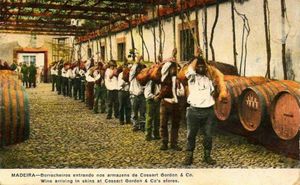The British brought rubber trees to Singapore (then British Malaya) in 1877, as part of a long-held plan to break the Brazilian stranglehold on rubber production. The first seedlings were planted in the Singapore Botanic Garden, and Southeast Asia quickly became the global center of the trade. After the second world war, the development of synthetic rubber and a skyrocketing Singaporean population meant the plantations’ land became more valuable than the trees themselves, and the last one shut down long before I was born.
But when my mother was a child, rubber plantations were still commonplace, tucked in among the rising housing estates. She grew up playing with rubber seeds because they were absolutely everywhere. One favorite “game” was to rub a seed till it was uncomfortably hot, then apply it to some unsuspecting friend.
I wanted to share this story as a companion to the recent pieces about rubber in Scope of Work. I love how my mother’s childhood delight grew from the machinations of empire – of which she, like all children, was entirely innocent. The omnipresence of rubber trees was just a fact of life for her, in spite of their having been brought to the region barely one human lifespan before she was born. I’m sure my grandparents explained rubber tapping to her at some point in her childhood, but would they have explained the webs of industry, power, politics, and suffering that brought these trees halfway round the world (and, indirectly, my grandparents to British Malaya), to amuse her and her playmates?
-TW Lim
The most clicked link from last week's issue (3% of opens) was a technical explainer on Disney World's Mickey & Minnie's Runaway Railway. In the Members' Slack, we've been talking about Belt & Road promotional videos, justifications for using Jira, and how basically all of us have tried chucking a manual coffee grinder into a cordless drill at some point. Join us today and get your first month of Membership free 💞
JOBS.
- New York Hall of Science is hiring an exhibit technician in NYC.
- Mill is hiring a product design engineer in San Bruno, CA.
- Wherefour is hiring a remote customer service implementation specialist in the US.
- BetaNYC is hiring a chief technical officer/chief civic hacking officer in NYC.
- If you're hiring designers, engineers, and operators, you can promote the roles you're hiring for here.
PLANNING & STRATEGY.
- Something I look forward to every time I’m in Europe is seeing the variety of small vehicles used to navigate the winding streets of historic city centers, the Bluebus and Citroen Ami being particular favorites. The Ami is technically a Quadricycle, one of several categories of microcars recognized in Europe. The closest US equivalent to this category is Neighborhood Electric Vehicles (NEVs), but microcars in Europe often benefit from relaxed registration and licensing requirements, whereas many US states don’t make it particularly easy to own and operate an NEV. I often wonder what the streets of older American cities like New York or Boston would look like if it were easier to have an NEV than a regular car. Instead, while microcars represent the European auto industry adapting to the realities of the built environment, the US is building environments to be safe spaces for NEVs.
- An argument that the explosion of Korean restaurants in the US over the last 10 years is the result of government efforts. We don’t often think about it as such, but tourism promotion is a form of industrial policy too.
MAKING & MANUFACTURING.
Madeira is a sweet fortified wine made on the Portuguese island of that name, distinguished by its savory, nutty flavors, and its ability to age for decades if not centuries.
The island of Madeira developed a thriving wine industry soon after its discovery by Europeans in 1419. It was a convenient stop for ships going from Europe to either the Indies or the Americas, so there was a ready market for its wines. These early wines, unfortified and unsweetened, often deteriorated by the time they reached their destinations, so Madeira’s winemakers began to add distilled alcohol to their wines as a preservative. Per the Oxford Companion to Wine, in the latter half of the 17th century, it was “found that madeira somehow tasted better after pitching and rolling across the tropics in the hull of a ship” – making it one of a very few products where delivery was an integral part of the manufacturing process. This discovery eventually led to the winemakers of Madeira sending their wines on round-trip voyages before recovering them to sell to passing ships once more.
I’m fascinated by what the intervening years must have been like, between the discovery that the wines benefited from the ocean voyage and the round-trips becoming common practice. How did the winemakers of Madeira take the news of their wines suddenly becoming much more popular in these faraway markets? How long did it take before they realized the wines really were transforming en route? And how did they ensure their buyers were getting the kind of wine they expected?
Modern madeira is aged in heated warehouses. At least one winery is making a wine aged on a tall ship in the name of historicity, but to my mind, a deliberate round trip is far less elegant than finishing on a one-way journey. Tangentially related: similar stories are told about Linie Aquavit; a modern bourbon aged at sea; and transport was supposedly integral in the making of Russian Caravan tea as well.
MAINTENANCE, REPAIR & OPERATIONS.
- Antique cross-cut saws perform better than modern ones, say rangers who have to use them in wilderness areas.
- Ura-dashi is the process of deforming the soft steel layer on the back of a Japanese block plane blade with a peening hammer. This reshapes the hard steel on the front, enabling proper sharpening.
DISTRIBUTION & LOGISTICS.
- US law requires firearms to be traced by rifling through paper files.
- From frequent SOW contributor Kelly Pendergrast, an argument that the walk-in pantry turns the home into a site for performative logistical labor. “The ritualized stockpiling and organizing of goods, the oversized scale and format of the shelves and bins – this is a space where the performance of logistics is as important as the performance of domesticity.”
INSPECTION, TESTING & ANALYSIS.
- Testing the efficacy of cleaning processes is a core part of food safety, and is harder when what you’re cleaning is an 80’ long piece of equipment that spends all its time on highways and fields. In this hour-long webinar, Dole representatives run a post-mortem on the process flaws that led to a multi-state listeria outbreak. Some lessons: Spray nozzle design matters; swab everything all the time; and nothing beats a full strip-down twice a year.
- The most commonly used sanitizers in US foodservice, quaternary ammonium compounds (commonly known as QACs or Quats), may not actually be safe. While it’s been known for some time that they’re dermal and respiratory irritants, a recent critical review found that they’re also linked to “developmental and reproductive toxicity, disruption of metabolic function such as lipid homeostasis, and impairment of mitochondrial function. QACs’ role in antimicrobial resistance has also been demonstrated.” QACs are the prevalent active ingredient in sanitizing spray and dish pits – workers are directed to apply the sanitizer and let the surface or object air dry. They’re also used in consumer products like shampoo and nasal spray, but usage really surged during the pandemic, when restaurants were required to sanitize surfaces even more frequently than usual (in spite of strong evidence that this was essentially public health theatre).
- A massive security flaw at Hyundai/Kia went undetected until it affected ~9M cars. While some of these cars apparently lack an immobilizer altogether, others have immobilizers which are bypassed by turning the ignition switch – which can be done with a standard USB-A plug. On the one hand, an ignition switch that can be spoofed with a common household object seems like a physical security vulnerability. On the other, it only matters if the software flaw also exists.
SCOPE CREEP.
- Promotional videos for the Belt and Road Initiative come in a panoply of styles: hip-hop singalong videos for adults and for kids, an animated explainer/bedtime story about infrastructure financing, boppy claymation music video, and basically a bank ad.
- I thought I was weird for taking photos of fire hydrants when I travel. Then I found the Fire Hydrants of Europe instagram.
Thanks as always to Scope of Work’s Members and Supporters for making this newsletter possible. Thanks also to Randy, Vaughn, Arnaud, Jeremy, Elizabeth, Diana, Spencer, and Karen Constable at the Rotten Apple newsletter for the links.
Love, tw
p.s. - A little known fact about Singapore is that it’s majority Chinese largely because the British imported indentured labor from China to work on their plantations there, which produced, among other things, latex for rubber.
p.p.s. - We care about inclusivity. Here’s what we’re doing about it.




